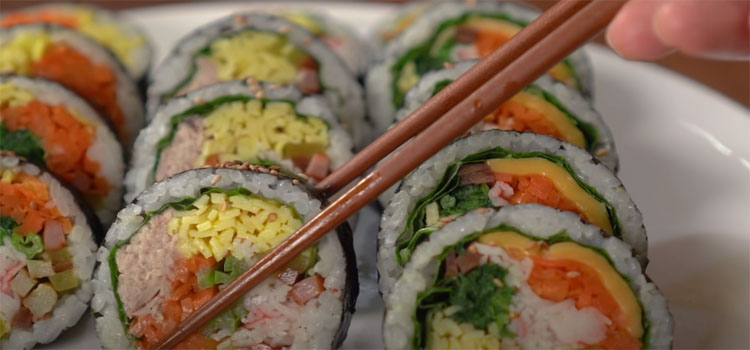Last Updated on September 15, 2024 by Shari Mason
Sushi enthusiasts argue passionately if their favorite dish tastes better **steaming hot or refreshingly cold.**
Today, we explore the art of savoring this beloved Japanese delicacy and unravel the mysteries of sushi temperature.
Let’s uncover the simple pleasures of sushi, understanding how its temperature can enhance our dining experiences and ignite our taste buds.
Is Sushi Traditionally Served Hot Or Cold?


Sushi [1] is traditionally served cold, embracing the art of simplicity and freshness.
Rooted in Japanese culinary traditions, the essence of sushi lies in the delicate balance of flavors and textures showcased through its raw or marinated fish, expertly seasoned rice, and thoughtfully selected ingredients.
The cool temperature of sushi allows the distinct flavors of the fish and other components to shine, while the chilled rice provides a pleasing contrast to the silky texture of the fish.
This timeless tradition of serving sushi cold has become synonymous with the elegance and purity that defines this beloved Japanese cuisine.
But can you use basmati rice for sushi?
How Does Temperature Affect The Flavors Of Sushi?
Temperature plays a significant role in shaping the flavors of sushi, influencing our sensory experience. When served cold sushi, the coolness helps preserve the raw fish’s freshness, enhancing its natural flavors and delicate textures.
The chilled rice contrasts, creating a harmonious balance between the fish’s coolness and the vinegared rice’s slight warmth.
“I love sushi. Once on Valentine’s Day, someone I was dating rocked up at the airport to pick me up with a bag of salmon because I love it so much.”
Ella Eyre, English Singer-Songwriter
The cool temperature also helps to highlight the subtle nuances of the accompanying ingredients, such as seaweed, vegetables, and condiments, allowing their flavors to shine through. But should you keep sushi in the fridge?
Are There Specific Types Of Sushi Meant To Be Eaten Hot?
Yes, specific types of sushi are meant to be eaten hot. While traditional sushi is typically served cold, some variations embrace warmth to bring out unique flavors and textures.
Examples include grilled eel (unagi) sushi, where the eel is cooked and then glazed with a sweet and savory sauce before being served atop a bed of rice.
Another example is tempura sushi, which features lightly battered and deep-fried seafood or vegetables, providing a crispy texture and a warm contrast to the cool rice.
Also Read:
Does Sushi Taste Better Hot Or Cold?


Both hot and cold sushi offer unique flavor profiles and experiences.
Cold sushi showcases the freshness and delicate textures of the raw fish, while the chilled rice provides a refreshing contrast.
On the other hand, hot sushi, such as grilled eel or tempura rolls, offers the warmth of cooked ingredients and a satisfying crispness.
“Whether savoring the cool elegance of raw fish or relishing the comforting warmth of cooked ingredients, let your palate be the guide as you embark on a personal sushi journey, where the answer lies in the harmonious marriage of taste and preference.”
Eat Pallet Restaurant & Food Advice
The choice ultimately comes down to individual taste and the desire for either the raw, relaxed elegance of traditional sushi or the comforting warmth of cooked variations.
Embrace the diversity of sushi experiences and savor each bite according to your preference.
Can You Enjoy Sushi Both Hot & Cold?
Yes. The beauty of sushi lies in its versatility, allowing us to enjoy it both hot and cold.
Embracing both temperature variations opens up a world of culinary delights, where we can experience the contrasting flavors, textures, and sensations offered by sushi prepared at different temperatures.
Indulge in the relaxed elegance of raw fish and chilled rice, appreciating the freshness and delicate flavors.
Then, relish the warmth and savory goodness of grilled or tempura [2] sushi, where the cooked ingredients provide a comforting and satisfying experience. But how long can sushi be left out?
FAQs
What temp should you eat sushi?
Sushi is typically enjoyed at a relaxed or slightly chilled temperature. The recommended serving temperature for sushi is around room temperature, which allows the flavors and textures to be appreciated fully.
Do you heat sushi rice?
No, sushi rice is not typically heated up before serving. Sushi rice is prepared by cooking short-grain rice and then seasoned with vinegar, sugar, and salt. Heating sushi rice can alter its texture and compromise its delicate balance.
In Conclusion
The temperature at which sushi is enjoyed depends on personal preference and the type of sushi being savored.
Traditionally, sushi is served cold, allowing the freshness of the raw fish to shine alongside the coolness of the seasoned rice.
This chilled presentation enhances the delicate flavors and textures, providing a refreshing culinary experience.
However, sushi variations are meant to be enjoyed hot, where cooked ingredients bring warmth and unique flavors to the palate.
References:
- https://www.thespruceeats.com/what-is-sushi-5079606
- https://www.allrecipes.com/recipe/129467/crispy-shrimp-tempura/
- Can You Put an AC Unit in the Kitchen? - September 27, 2024
- What Cheese Does Olive Garden Use? Discover Their Signature - September 27, 2024
- How to Cancel a Pizza Hut Order? Quick & Easy Guide - September 24, 2024


